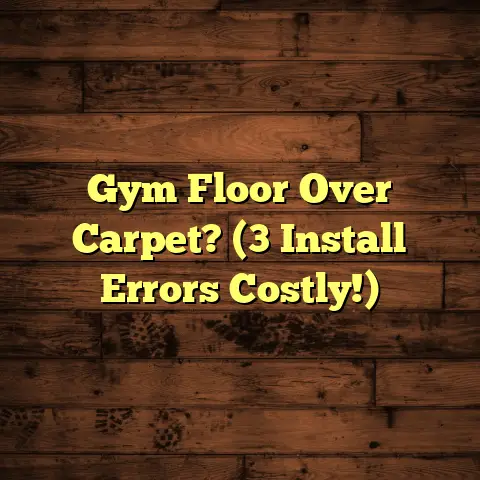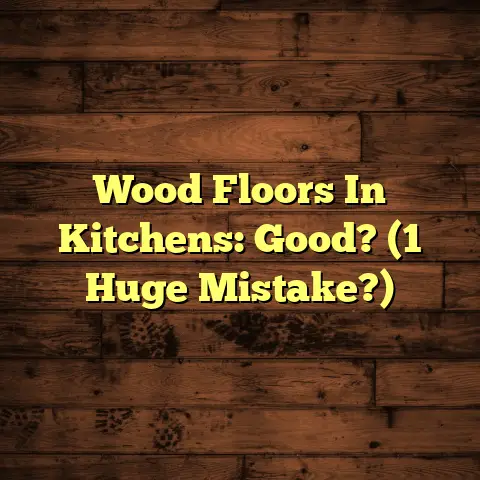Smart Home Flooring: Key Factors (6 Hidden Costs!)
But when we think about smart homes, we usually picture fancy lights or a talking thermostat. What about the floor beneath your feet? Yep, flooring is getting smart too, and it can make a real difference.
But before you dive in, let’s talk about the key things you need to know and, even more importantly, the hidden costs that can sneak up on you. Trust me, I’ve seen it all in my years as a flooring contractor.
Section 1: Understanding Smart Home Flooring
Definition and Overview
So, what exactly is “smart home flooring”? It’s more than just a pretty surface. We’re talking about flooring that integrates with your smart home ecosystem. Think sensors, integrated heating, even flooring that can detect leaks. It’s all about adding layers of convenience and control.
For example, some new tech includes sensors that monitor foot traffic patterns in your home and automatically adjust lighting or temperature in those areas. Pretty neat, huh? Or imagine underfloor heating that learns your schedule and warms up the bathroom floor just before you wake up.
Importance for Modern Living
Why is this important? Well, think about your busy life. Smart flooring can free up your time and reduce your stress. Imagine not having to manually adjust the thermostat all the time. Or getting an alert on your phone if there’s a water leak under your kitchen floor.
According to a study by Statista, the smart home market is projected to reach $53.4 billion in 2024. Flooring is a piece of that pie, and its importance is only going to grow as we look for ways to make our homes more efficient and user-friendly.
Section 2: Key Factors in Smart Home
Flooring Selection
Okay, so you’re intrigued. Now let’s dive into the nitty-gritty. What should you consider when choosing smart home flooring?
-
Material Choices
When it comes to flooring, you’ve got options—lots of them! Hardwood, laminate, tile, carpet… each has its pros and cons.
-
Hardwood: Classic, beautiful, and can increase your home’s value. But it can be pricey and requires more maintenance.
-
Laminate: A more affordable alternative to hardwood. It’s durable and easy to clean, but it doesn’t have the same warmth as real wood.
-
Tile: Great for kitchens and bathrooms because it’s water-resistant and easy to clean. Plus, there are tons of styles to choose from. But it can be cold underfoot.
-
Carpet: Soft, cozy, and can help insulate your home. But it can stain easily and requires regular vacuuming.
For busy homeowners, durability and ease of maintenance are key. Nobody wants to spend their precious free time scrubbing floors!
-
-
Integration with Smart Technology
This is where things get really interesting. How well does the flooring integrate with your existing smart home systems? Can you easily connect it to your thermostat, security system, or lighting?
Underfloor heating is a big one. It can be controlled via your smart home app, allowing you to set schedules and adjust the temperature from anywhere. Moisture sensors are another cool feature. They can detect leaks and alert you before they cause major damage.
Smart flooring can also contribute to energy efficiency. For instance, some systems use sensors to detect when a room is unoccupied and automatically lower the temperature.
-
Aesthetic Appeal vs. Functionality
Let’s be real: You want your floors to look good, but they also need to be practical. Finding the right balance between aesthetics and functionality is crucial.
For example, you might love the look of glossy hardwood, but it might not be the best choice if you have kids or pets who are prone to making messes. A more durable, stain-resistant option like laminate might be a better fit.
Trends in design are always evolving. Right now, I’m seeing a lot of homeowners opting for minimalist designs with clean lines and neutral colors. These styles tend to be both visually appealing and easy to maintain.
-
Installation Process
Installing smart flooring can be a bit more complicated than laying down regular flooring. There’s wiring to consider, sensors to install, and connections to make to your smart home system.
The installation process can take anywhere from a few days to a few weeks, depending on the size of the project and the complexity of the system. It’s important to factor in potential disruptions to your daily life.
DIY is an option, but I usually advise against it, especially if you’re not comfortable working with electrical wiring. Hiring a professional ensures that the job is done correctly and safely.
-
Maintenance and Longevity
How much time and effort are you willing to put into maintaining your floors? Different types of flooring have different maintenance requirements.
Hardwood needs to be polished and sealed regularly. Tile requires occasional grout cleaning. Carpet needs to be vacuumed frequently and professionally cleaned every year or two.
The expected lifespan of your flooring also varies depending on the material. Hardwood can last for decades with proper care, while laminate might need to be replaced after 10-15 years.
Choosing long-lasting options can save you money in the long run and reduce the hassle of having to replace your floors frequently.
-
Cost Considerations
Of course, cost is a major factor. Smart flooring can be a significant investment, so it’s important to understand the initial costs versus the long-term benefits.
The initial investment includes the cost of the flooring materials, installation, and any necessary smart home components. Long-term costs include energy savings, maintenance, and potential repairs.
For example, underfloor heating can significantly reduce your energy bills over time, but it also requires a larger upfront investment.
Section 3: Unveiling the 6 Hidden Costs
of Smart Home Flooring
Alright, let’s get to the part you’ve been waiting for: the hidden costs. These are the expenses that often get overlooked but can really add up.
-
Installation Costs
We talked about this a bit earlier, but it’s worth diving into more detail. Professional installation can be pricey, especially if you’re dealing with complex smart home systems.
According to HomeAdvisor, the average cost to install flooring ranges from $6 to $11 per square foot. But that’s just for basic flooring. Smart flooring can easily double or triple that cost.
DIY might seem like a cheaper option, but don’t forget to factor in the cost of tools and the value of your time. Plus, if you mess something up, you could end up paying even more to fix it.
-
Upkeep and Maintenance
Maintenance is an ongoing expense that many homeowners don’t fully consider. Cleaning supplies, repairs, and service contracts can all add up.
For example, if you have hardwood floors, you’ll need to invest in special cleaners and polishes to keep them looking their best. And if you have underfloor heating, you might need to schedule regular maintenance to ensure that the system is working properly.
I’ve seen homeowners spend hundreds of dollars each year on maintenance alone. It’s important to factor these costs into your budget.
-
Energy Costs
Smart flooring is supposed to save you money on energy, right? Well, that’s not always the case. Inefficient systems or improper use can actually increase your energy consumption.
For example, if you leave your underfloor heating running all day, even when you’re not home, you’re wasting energy and money. It’s important to set up schedules and use sensors to optimize your energy usage.
According to the U.S. Energy Information Administration, the average household spends over $2,000 per year on energy bills. Smart flooring can help reduce that number, but only if it’s used correctly.
-
Technology Upgrades
Technology is constantly evolving, and that includes smart home technology. You might need to upgrade or replace your smart flooring components every few years to keep up with the latest advancements.
Compatibility issues can also be a problem. If you upgrade your smart home system, you might find that it’s not compatible with your existing smart flooring. This can force you to replace your flooring or invest in expensive adapters.
I’ve seen homeowners spend thousands of dollars on technology upgrades just to keep their smart homes up to date. It’s something to keep in mind.
-
Replacement Costs
Even the most durable flooring will eventually wear out. Wear and tear, accidents, and changing tastes can all lead to the need for replacement.
Replacing your flooring can be a major expense, especially if you have a large home. It’s important to choose materials that are durable and long-lasting to minimize the need for replacement.
I always tell my clients to think about the long-term cost implications of their flooring choices. A cheaper option might seem appealing at first, but it could end up costing you more in the long run if it needs to be replaced sooner.
-
Insurance and Liability
Did you know that smart flooring can impact your home insurance premiums? It’s true! Some insurance companies offer discounts for homes with smart home features, such as leak detection systems.
However, you also need to consider liability. If someone gets injured on your property due to a flooring issue, you could be held liable. It’s important to have adequate insurance coverage to protect yourself.
I always advise homeowners to talk to their insurance provider about their smart flooring and make sure they have the right coverage.
Conclusion
Choosing smart home flooring can be a game-changer, adding convenience and efficiency to your busy life. But it’s important to go in with your eyes open. Understanding the key factors and being aware of the hidden costs can help you make informed decisions that align with your lifestyle and budget.
Remember, it’s not just about the initial investment. Think about the long-term costs, including maintenance, energy savings, and potential repairs. And don’t forget to factor in the value of your time and the potential disruptions to your daily life.
By approaching your flooring decisions with a comprehensive understanding, you can create a smart home that is both beautiful and functional. Good luck!





